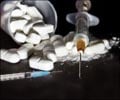Disrupting memories associated with substance abuse use reduces drug seeking behaviors, thereby opening a potential avenue for developing more effective therapies to prevent drug relapse.

TOP INSIGHT
The study findings may help researchers develop drugs or approaches like deep brain stimulation to specifically target these memories strengthened by substance use and improve the success of exposure therapy to prevent relapse.
"While we've always known that the brain forms these cue-associated memories, the specific circuits have never been clearly identified," said Mary Torregrossa, Ph.D., associate professor of psychiatry at Pitt's School of Medicine and senior author of the study, published today in Cell Reports. "We've found a central piece in the cue-memory puzzle, and we also show that taking out that piece in a substance use scenario can help reverse relapse-like behaviors."
In the study, the scientists used a rat model of cue-associated relapse. When rats pressed a lever, they received an infusion of cocaine, accompanied by a tone and a light. With training, the rats learned to associate the audiovisual cue with the cocaine high, and exhibited drug-seeking behavior analogous to craving, repeatedly pressing the lever.
The researchers also simulated exposure therapy in the rats, showing that repeatedly playing the tone and light without providing the cocaine infusion eventually reduced drug-seeking behavior. But much like in humans, exposure therapy in the rats did not work well if they were placed in a different environment.
Using electrical recordings from rat brain tissue, Torregrossa and her team first showed that connections between the medial geniculate nucleus - the brain's switchboard for sound - and the lateral amygdala are important for forming memories that associate the cocaine high with external cues.
To show a causal connection between these cue-associated memories and drug-seeking behavior, the researchers used a technique known as optogenetics, where light pulses are used to control genetically modified cells, to control the neurons from the previous experiment. Rats that had the cocaine-cue memories optogenetically erased pressed the lever significantly fewer times when the light and tone cue were played.
Source-Eurekalert
 MEDINDIA
MEDINDIA




 Email
Email







